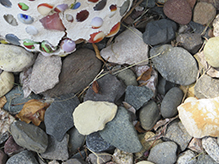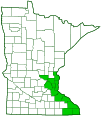sulphur-winged grasshopper
(Arphia sulphurea)
Conservation • Description • Habitat • Ecology • Distribution • Taxonomy
Conservation Status |
|
|||||||
| IUCN Red List | not listed |
|||||||
| NatureServe | N5 - Secure |
|||||||
| Minnesota | not listed |
|||||||
Description |
||
Sulphur-winged grasshopper is a small, early season, band-winged grasshopper. It occurs in the United States east of the Great Plains and in southern Ontario Canada. It reaches the western extent of its range in southeastern Minnesota. Adults are found from April to July in open woodlands with a grassy understory, in prairies, and on roadsides. In Minnesota it is most common on sparsely vegetated sandy soils and on bluff prairies. Female adults are robust, 1⅛″ to 1½″ (28 to 38 mm) in length, and pale brown to dark brown. Males are more slender and smaller, ⅞″ to 1¼″ (23 to 31 mm) in length. The face is vertical. On the upper part of the head (vertex) there is a deep depression (concavity) in the middle and a shallow depression (foveola) on each side. The concavity is as wide as long and is divided beyond the middle by a curved, low but distinct, horizontal ridge. The front of the concavity is strongly ascending. The foveolae are large, shallow, and triangular to rhomboidal. The upper part of the forehead (fastigium) is very narrow in front. The plate on the upper face (frontal costa) is long and narrow. There are three small simple eyes (ocelli), one below each foveola (lateral ocelli) and one near the middle of the costa (median ocellus). The costa is strongly narrowed above where it meets the vertex. It is less than half as wide at the vertex than it is below the median ocellus. The plate over the thorax (pronotum) is saddle-shaped and has a distinct longitudinal ridge (carina) in the middle. The carina is raised and sharply compressed. There is a single transverse groove (suculus) across the pronotum, but it does not cut through the carina. The lateral lobes of the pronotum are squared. The rear margin is extended backward and triangular. It does not extend over the abdomen or beyond the base of the wings. The front margin is extended forward and rounded or broadly angled. The surface of the pronotum is rough and wrinkled. On the underside of the thorax there is no spur between the front legs. The forewings (tegmina) are long, leathery, and densely veined. When folded over the body the top is often pale. On the male there is often a yellowish band at the tip. The hindwings are membranous and are folded fan-like when at rest. They are sulphur yellow with a broad, curved, black band on the outer margin. The band extends toward the wing base on the inner margin. The coloration of the third segment (femur) of the hind leg is variable. It may be dark brown with a pale ring at the tip or have alternating dark and light bands. The fourth segment (tibia) is dark with a yellow ring at the base. |
||
Size |
||
Female total length: 1⅛″ to 1½″ (28 to 38 mm) Male total length: ⅞″ to 1¼″ (23 to 31 mm) |
||
Similar Species |
||
Habitat |
||
Open woodlands, prairies, roadsides, and bluff prairies; sparsely vegetated sandy soils |
||
Ecology |
||
Season |
||
One generation per year: April to July |
||
Behavior |
||
When seeking a mate, males and sometimes females produce a crackling or buzzing sound (crepitation) when in flight. |
||
Life Cycle |
||
Nymphs overwinter |
||
Nymph Food |
||
|
||
Adult Food |
||
Mostly grasses, especially Kentucky bluegrass, but also other forbs |
||
Distribution |
||||
|
Sources Haarstad, J. 1990. The Acrididae of Minnesota. Final report submitted to the Minnesota Department of Natural Resources. 28 pp. |
|||
| 7/2/2023 | ||||
Occurrence |
||||
|
||||
Taxonomy |
|||
Order |
Orthoptera (grasshoppers, crickets, and katydids) | ||
Suborder |
Caelifera (grasshoppers, locusts, and allies) | ||
| Infraorder | Acrididea (grasshoppers) | ||
Superfamily |
Acridoidea (short-horned grasshoppers and locusts) | ||
Family |
Acrididae (short-horned grasshoppers) | ||
Subfamily |
Oedipodinae (bandwing grasshoppers) | ||
| Subtribe | Arphiini | ||
Genus |
Arphia | ||
Synonyms |
|||
Gryllus sulphureus Locusta sulphureus Tomonotus sulphureus Oedipoda sulphureus |
|||
Common Names |
|||
spring yellow-winged grasshopper spring yellow-winged locust sulphur-winged grasshopper |
|||
Glossary
Carina
An elevated keel or ridge.
Fastigium
On some insects, especially Orthoptera: the upper part of the forehead, between and often extending in front of the compound eyes.
Femur
On insects and arachnids, the third, largest, most robust segment of the leg, coming immediately before the tibia. On humans, the thigh bone.
Ocellus
Simple eye; an eye with a single lens. Plural: ocelli.
Pronotum
The exoskeletal plate on the upper side of the first segment of the thorax of an insect.
Tegmen
The modified, leathery front wing of grasshoppers and related insects that protects the hindwing. It may also serve as a camouflage, a defensive display, or a sound board. Plural: tegmina.
Tibia
The fourth segment of an insect leg, after the femur and before the tarsus (foot). The fifth segment of a spider leg or palp. Plural: tibiae.
Vertex
The upper surface of an insect’s head.
Sulfur or sulphur?
In American English, the usual spelling is sulfur. Outside of North America, the usual spelling in non-scientific texts is sulphur. In scientific texts throughout the English-speaking world sulphur is the norm but sulfur is gaining ground.
Visitor Photos |
|||||
Share your photo of this insect. |
|||||
| This button not working for you? Simply email us at info@MinnesotaSeasons.com. Attach one or more photos and, if you like, a caption. |
|||||
Nancy Lundquist |
|||||
I have never seen anything grasshopper-like that small. If I hadn't been picking up some pieces of a toad house my granddaughter made I would never have seen it. |
 |
||||
MinnesotaSeasons.com Photos |
|||||
|
|||||

Slideshows |
||

Visitor Videos |
|||
Share your video of this insect. |
|||
| This button not working for you? Simply email us at info@MinnesotaSeasons.com. Attach a video, a YouTube link, or a cloud storage link. |
|||
Other Videos |
|||
| Sulphur-winged Grasshopper (Acrididae: Arphia sulphurea) Nymph Carl Barrentine |
|||
About
Apr 4, 2011 The first grasshopper of Spring! One of two nymphs, both of the same species, that I found hopping in sun-warmed, brown, dry grasses that were buried in snow only a week ago. Photographed at Turtle River State Park, North Dakota (01 April 2011). Thank you to David Ferguson (@ Bugguide.net) for identifying this specimen! |
|||
| Carolina Grasshopper (Acrididae: Dissosteira carolina) on Gravel Carl Barrentine |
|||
About
Jul 21, 2009 Photographed at Turtle River State Park, North Dakota (20 July 2009). "Desdemona was small and fair, / Delicate as a grasshopper / At the tag-end of summer: A Venetian / To her noble finger-tips." --John Peale Bishop |
|||
| Sulphur-Winged Grasshopper Macro World |
|||
About
Oct 4, 2020 Arphia sulphurea, known generally as sulphur-winged grasshopper, is a species of band-winged grasshopper in the family Acrididae. Other common names include the spring yellow-winged locust and spring yellow-winged grasshopper. It is found in North America |
|||


Created: 7/2/2023
Last Updated:

